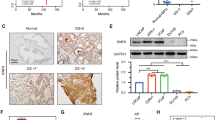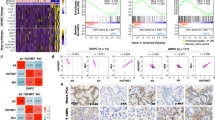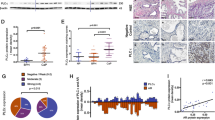Abstract
Alteration of the AR functions due to amplification, overexpression and somatic mutation of the AR itself or altered interaction of AR with other cell growth regulatory proteins, may contribute to a significant subset of advanced prostate cancer (CaP). Very little is known about the pathways impacted by AR dysfunctions, although CaP associated AR alterations suggest the biological role of the AR dysfunction in disease progression. Comparative evaluations of wild type (wt) AR and mutant (mt) ARs in appropriate experimental models should provide a better understanding of the functional impact of AR alterations in CaP. Here, we provide direct evidence showing cell growth/cell survival promoting effects of the widely studied CaP associated AR mutation (T877A). In contrast to Ad-wtAR or Ad-control infected LNCaP or LAPC4 cells, Ad-mtAR (T877A) infected LNCaP or LAPC4 cells continued to grow in the androgen-deprived medium and exhibited an androgen independent AR-transcription factor activity. Further, Ad-mtAR (T877A) infected LNCaP or LAPC4 cells exhibited enhanced cell growth in the presence of lower concentrations of the synthetic androgen, R1881. Of note, Ad-mtAR (T877A) infected LNCaP cells showed striking resistance to cell growth inhibition/apoptosis mediated by the wt p53. Taken together, these findings provide novel insights into the AR dysfunctions resulting from the T877A mutation and functionally similar AR alterations may provide selective cell growth/survival advantage for CaP progression. These observations have important implications for developing biology-based prognostic biomarkers and therapeutic strategies for CaP showing such AR dysfunctions.
This is a preview of subscription content, access via your institution
Access options
Subscribe to this journal
Receive 50 print issues and online access
$259.00 per year
only $5.18 per issue
Buy this article
- Purchase on Springer Link
- Instant access to full article PDF
Prices may be subject to local taxes which are calculated during checkout






Similar content being viewed by others
Abbreviations
- AR:
-
androgen receptor
- wt:
-
wild-type
- mt:
-
mutant
- CaP:
-
prostate cancer
- FBS:
-
fetal bovine serum
- cFBS:
-
charcoal/dextran stripped FBS
- pfu:
-
plaque-forming unit
- GAPDH:
-
glyceraldehyde phosphate dehydrogenase
- PSA:
-
prostate specific antigen
- Dx:
-
doxorubicin
References
Arrowsmith CH . (1999). Cell Death Differ 6: 1169–1173.
Bauer JJ, Sesterhenn IA, Mostofi KF, McLeod DG, Srivastava S, Moul JW . (1995). Clin Cancer Res 1: 1295–1300.
Chen CD, Welsbie DS, Tran C, Baek SH, Chen R, Vessella R et al. (2004). Nat Med 10: 33–39.
Culig Z, Hobisch A, Bartsch G, Klocker H . (2000). Urol Res 28: 211–219.
Culig Z, Hoffmann J, Erdel M, Eder IE, Hobisch A, Hittmair A et al. (1999). Br J Cancer 81: 242–251.
Feldman BJ, Feldman D . (2001). Nat Rev Cancer 1: 34–45.
Gaddipati JP, Mcleod DG, Heidenberg HB, sesterhenn IA, Finger MJ, Moul JW et al. (1994). Cancer Res 54: 2861–2864.
Gelmann EP . (2002). J Clin Oncol 20: 3001–3015.
Grossmann ME, Huang H, Tindall DJ . (2001). J Natl Cancer Inst 93: 1687–1697.
Haag P, Bektic J, Bartsch G, Klocker H, Eder IE . (2005). J Steroid Biochem Mol Biol 96: 251–258.
Han G, Buchanan G, Ittmann M, Harris JM, Yu X, Demayo FJ et al. (2005). Proc Natl Acad Sci USA 102: 1151–1156.
He TC, Zhou S, da Costa LT, Yu J, Kinzler KW, Vogelstein B . (1998). Proc Natl Acad Sci USA 95: 2509–2514.
Heidenberg HB, Sesterhenn IA, Gaddipati JP, Weghorst CM, Buzard GS, Moul JW et al. (1995). J Urol 154: 414–421.
Huggins C, Hodges CV . (1941). Cancer Res 1: 293–297.
Ioffe ML, White E, Nelson DA, Dvorzhinski D, DiPaola RS . (2004). Prostate 61: 243–247.
Landis SH, Murray T, Bolden S, Wingo PA . (1999). CA Cancer J Clin 49: 8–31.
Liao X, Tang S, Thrasher JB, Griebling TL, Li B . (2005). Mol Cancer Ther 4: 505–515.
Nakao R, Haji M, Yanase T, Ogo A, Takayanagi R, Katsube T et al. (1992). J Clin Endocrinol Metab 74: 1152–1157.
Raffo AJ, Perlman H, Chen MW, Day ML, Streitman JS, Buttyan R . (1995). Cancer Res 55: 4438–4445.
Rokhlin OW, Taghiyev AF, Guseva NV, Glover RA, Chumakov PM, Kravchenko JE et al. (2005). Oncogene 24: 6773–6784.
Schuurmans AL, Bolt J, Veldscholte J, Mulder E . (1990). J Steroid Biochem Mol Biol 37: 849–853.
Segawa T, Takebayashi H, Kakehi Y, Yoshida O, Narumiya S, Kakizuka A . (1998). Cancer Res 58: 2282–2287.
Shi XB, Ma AH, Xia L, Kung HJ, de Vere White RW . (2002). Cancer Res 62: 1496–1502.
Small EJ . (1998). Curr Opin Oncol 10: 244–252.
Sobel RE, Sadar MD . (2005). J Urol 173: 342–359.
Srivastava S, Katayose D, Tong YA, Craig CR, McLeod DG, Moul JW et al. (1995). Urology 46: 843–848.
Taplin ME, Balk SP . (2004). J Cell Biochem 91: 483–490.
Taplin ME, Bubley GJ, Ko YJ, Small EJ, Upton M, Rajeshkumar B et al. (1999). Cancer Res 59: 2511–2515.
Tsui KH, Chang PL, Lin HT, Juang HH . (2004). J Urol 172: 2035–2039.
van Bokhoven A, Varella-Garcia M, Korch C, Johannes WU, Smith EE, Miller HL et al. (2003). Prostate 57: 205–225.
Veldscholte J, Ris-Stalpers C, Kuiper GG, Jenster G, Berrevoets C, Claassen E et al. (1990). Biochem Biophys Res Commun 173: 534–540.
Wen AJ, Hu MC, Makino K, Spohn B, Bartholomeusz G, Yan DH et al. (2000). Cancer Res 60: 6841–6845.
Xu LL, Srikantan V, Sesterhenn IA, Augustus M, Dean R, Moul JW et al. (2000). J Urol 163: 972–979.
Yang C, Cirielli C, Capogrossi MC, Passaniti A . (1995). Cancer Res 55: 4210–4213.
Yap DB, Hsieh JK, Chan FS, Lu X . (1999). Oncogene 18: 7681–7689.
Zegarra-Moro OL, Schmidt LJ, Huang H, Tindall DJ . (2002). Cancer Res 62: 1008–1013.
Acknowledgements
We thank Drs Lionel Bañez, Katsuaki Masuda, Kee-Hong Kim and Ms Jennifer Regalia for the helpful suggestions. This research was supported by a grant from the Center for Prostate Disease Research Program through the Henry M Jackson Foundation for the Advancement of Military Medicine (Rockville, MD), funded by the US Army Medical Research and Materiel Command under contract number HU001-04-C-1502 (2004) with the Uniformed Services University. The opinions and assertions contained herein are the private views of the authors and are not to be considered as reflecting the views of the US Army or the Department of Defense.
Author information
Authors and Affiliations
Corresponding author
Additional information
Supplementary Information accompanies the paper on Oncogene website (http://www.nature.com/onc).
Rights and permissions
About this article
Cite this article
Sun, C., Shi, Y., Xu, L. et al. Androgen receptor mutation (T877A) promotes prostate cancer cell growth and cell survival. Oncogene 25, 3905–3913 (2006). https://doi.org/10.1038/sj.onc.1209424
Received:
Revised:
Accepted:
Published:
Issue Date:
DOI: https://doi.org/10.1038/sj.onc.1209424
Keywords
This article is cited by
-
Computationally guided discovery of novel non-steroidal AR-GR dual antagonists demonstrating potency against antiandrogen resistance
Acta Pharmacologica Sinica (2023)
-
A Targeted Bivalent Androgen Receptor Binding Compound for Prostate Cancer Therapy
Hormones and Cancer (2019)
-
Androgenic modulation of AR-Vs
Endocrine (2018)
-
Development of β-amino-carbonyl compounds as androgen receptor antagonists
Acta Pharmacologica Sinica (2014)
-
Androgen receptor signaling in prostate cancer
Cancer and Metastasis Reviews (2014)



